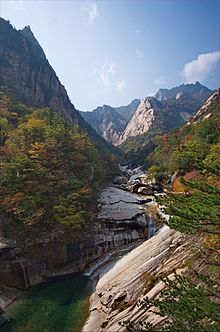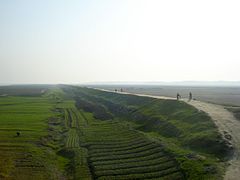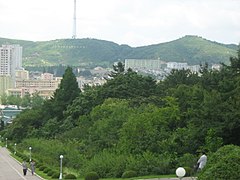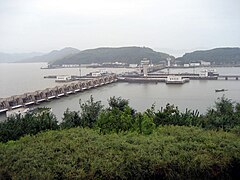Environment of North Korea - Wikipedia
Environment of North Korea
From Wikipedia, the free encyclopedia
Jump to navigationJump to search

Kumgang Mountain
The environment of North Korea comprises the diverse ecosystems of the part of the Korean peninsula controlled by the Democratic People's Republic of Korea. Since the 1980s, the environment has been reported to be in a state of "crisis", "catastrophe", or "collapse".[1][2][3]
Contents
1Overview
2Biodiversity
2.1Flora
3Environmental problems
3.1Pollution
3.2Deforestation
4Environmental programs
5Gallery
6See also
7References
8External links
Overview[edit]
More than 80 percent of North Korea is mountainous with cultivation largely confined to coastal strips in the east and west.[4] According to a United Nations Environmental Programme report in 2003, forest covers over 70 percent of the country, mostly on steep slopes.[5] However, other studies have suggested that, due to deforestation, forest cover was only about 50%.[6] There are nine rivers and numerous smaller waterways.[7] The environment is correspondingly diverse, consisting of alpine, forest, farmland, freshwater, and marine ecosystems.[8]
Due to its geological history, the country has a range of vegetation, from the subtropical, temperate and frigid zones, which are able to coexist due to the combined effects of oceanic and continental climates.[9] The climate has pronounced seasonal variations, with warm summers and snowfall in winter.[10]
Biodiversity[edit]
Further information: List of mammals of North Korea and List of birds of North Korea
In 2003, animal and plant species in North Korea were reported to be "profuse". Four percent of the higher plant species were reported to be endangered, vulnerable, rare, or in decline. Eleven percent of vertebrate species were reported to be critically endangered, endangered, or rare.[11]
In 2013 a delegation of visiting scientists reported major environmental devastation. They described an absence of wildlife and said that the "landscape is basically dead". This situation was described as "so severe it could destabilize the whole country".[2]
However, a group of birdwatchers from the Pukorokoro Miranda Naturalists' Trust, New Zealand, visited the Yellow Sea shore of Mundŏk County in South P'yŏngan province in 2016 and reported that the mudflats there were a haven for bird life. The relative lack of development there compared to nearby China and South Korea had provided a refuge for several internationally important birds on their migration along the East Asian-Australasian Flyway - such as the critically endangered Eastern curlew, the Eurasian curlew and the bar-tailed godwit.[12]
Flora[edit]
Main article: Flora of North Korea
The flora of North Korea has much in common with that of other areas of the northern hemisphere. 2898 species have been recorded, of which 14% are endemic. Four are classified as threatened.[13]
The native plant communities in the lowlands have largely disappeared with cultivation and urbanisation. Native conifer forest communities are located in the highlands. The forest types are mainly subarctic (boreal) and cool-temperate forest.[14]
Environmental problems[edit]

Smog at street level in Pyongyang.
Pollution[edit]
In 2003, air pollution in Pyongyang, largely due to combustion of coal, was reported to be unacceptable.[1][15] This is somewhat mitigated by the high use of public transportin urban areas.[16]
In 2003, the pollution of rivers and streams was reported to be "severe" due to a decrease in investment in environmental protection and the improper discharge of untreated sewage and industrial effluent. The quality of the Taedong River, which flows through Pyongyang, was reported to be "deteoriating", exacerbated by the construction of the West Sea Barrage.[1][17] A survey conducted in 2017 found that 93% of sanitation facilities were not connected to a sewage system. Rather, the human waste was used as fertilizer on fields, creating the potential health risk of spreading intestinal worms.[18]
North Korea produces large quantities of DDT and other pesticides.[19]
Deforestation[edit]
Cultivation, logging, and natural disasters have all put pressure on North Korea's forests. During the economic crisis of the 1990s, deforestation accelerated, as people turned to the woodlands to provide firewood and food. This in turn has led to soil erosion, soil depletion, and increased risk of flooding.[1][2][3][20]
Based on satellite imagery, it has been estimated that 40 percent of forest cover has been lost since 1985.[21] The United Nations Environmental Programme in 2003 reported a much smaller rate of depletion.[22]
Environmental programs[edit]
In response to the deforestation problem, North Korea has implemented a tree planting program.[23][24] In 2016, the Korean Central News Agency reported that the Central Nursery under the Ministry of Land and Environment Protection had produced 90 million saplings over the past five years for distribution around the country.[25] Official pronouncements have labeled illegal forest destruction as "treachery" and threatened perpetrators with the death penalty.[26] In 2017, Kim Il-sung University announced the opening of a new Forest Science Department.[27] In 2018, North Korea made an agreement with the South on forestry co-operation.[28]
The North Korean government has ratified the Kyoto Protocol on global warming and has been co-operating with international efforts to combat climate change.[29] It has invested in the development of solar and other renewable energy technology.[30] In 2017, the Foreign Ministry condemned the US government for withdrawing from the Paris Agreement.[31]
North Korea has participated in international environmental projects, such as the conservation of the red-crowned crane.[32] In 2017, Pyongyang hosted a workshop on the conservation of wetlands and migratory waterbirds, attended by the International Union for the Conservation of Nature, the Hanns Seidel Foundation, and the East Asian Australasian Flyway Partnership.[33]
Gallery[edit]

A North Korean agricultural landscape

Myohyang Mountain

North Korean countryside

Forested slopes around Kaesong

Mountains in North Korea

North Korean river

Hwanghae Province scenery

Yalu River Delta

North Korean coastline

West Sea Barrage
See also[edit]
Geography of North Korea
References[edit]
- ^ Jump up to:a b c d Tenenbaum, David J. (2005). "International Health: North Korean Catastrophe". Environ Health Perspect. 113 (1): A26. doi:10.1289/ehp.113-a26. PMC 1253723. PMID 15643724.
- ^ Jump up to:a b c McKenna, Phil (March 6, 2013). "Inside North Korea's Environmental Collapse". PBS.
- ^ Jump up to:a b Kirby, Alex (August 27, 2004). "North Korea's environment crisis". BBC.
- ^ United Nations Environmental Programme. "DPR Korea: State of the Environment, 2003" (PDF). p. 53. Archived from the original (PDF) on 2004-09-01.
- ^ United Nations Environmental Programme. "DPR Korea: State of the Environment, 2003" (PDF). p. 12. Archived from the original (PDF) on 2004-09-01.
- ^ Hayes, Peter (12 October 2009). "Unbearable Legacies: The Politics of Environmental Degradation in North Korea". Asia Pacific Journal: Japan Focus.
- ^ United Nations Environmental Programme. "DPR Korea: State of the Environment, 2003" (PDF). p. 30. Archived from the original (PDF) on 2004-09-01.
- ^ United Nations Environmental Programme. "DPR Korea: State of the Environment, 2003" (PDF). pp. 13, 52. Archived from the original (PDF) on 2004-09-01.
- ^ United Nations Environmental Programme. "DPR Korea: State of the Environment, 2003" (PDF). p. 12. Archived from the original (PDF) on 2004-09-01.
- ^ United Nations Environmental Programme. "DPR Korea: State of the Environment, 2003" (PDF). p. 11. Archived from the original (PDF) on 2004-09-01.
- ^ United Nations Environmental Programme. "DPR Korea: State of the Environment, 2003" (PDF). p. 53. Archived from the original (PDF) on 2004-09-01.
- ^ "Why North Korea is a safe haven for birds". BBC News. 2016-06-20. Retrieved 2016-06-20.
- ^ Haggett, Peter (2001). Encyclopedia of World Geography. Marshall Cavendish. p. 3088. ISBN 0761472894.
- ^ Jirí Kolbek; Ivan Jarolímek; Milan Valachovic (2003). "8: Forest Vegetation of the Northern Korean Peninsula". In Jirí Kolbek; Miroslav Šrůtek. Forest Vegetation of Northeast Asia. Springer. pp. 264, 294. ISBN 1402013701.
- ^ United Nations Environmental Programme. "DPR Korea: State of the Environment, 2003" (PDF). pp. 37–38. Archived from the original (PDF) on 2004-09-01.
- ^ United Nations Environmental Programme. "DPR Korea: State of the Environment, 2003" (PDF). p. 43. Archived from the original (PDF) on 2004-09-01.
- ^ United Nations Environmental Programme. "DPR Korea: State of the Environment, 2003" (PDF). p. 29. Archived from the original (PDF) on 2004-09-01.
- ^ Miles, Tom (21 June 2018). "Tackling North Korea's chronically poor sewage 'not rocket science': U.N." Reuters.
- ^ Hayes, Peter (12 October 2009). "Unbearable Legacies: The Politics of Environmental Degradation in North Korea". Asia Pacific Journal: Japan Focus.
- ^ "The Environment Is So Bad in North Korea, They'll Even Let Americans Help". The Atlantic Wire. April 3, 2012.
- ^ Raven, Peter (2013-09-09). "Engaging North Korea through Biodiversity Protection". Science & Diplomacy. 2 (3).
- ^ United Nations Environmental Programme. "DPR Korea: State of the Environment, 2003" (PDF). pp. 25–27. Archived from the original (PDF) on 2004-09-01.
- ^ "North Korean Cabinet Adopts Forest Restoration Resolution". The Institute of Far Eastern Studies. 15 March 2015. Retrieved 18 April 2015.
- ^ United Nations Environmental Programme. "DPR Korea: State of the Environment, 2003" (PDF). pp. 25–27. Archived from the original (PDF) on 2004-09-01.
- ^ "90 Millions of Saplings Produced at Central Nursery". KCNA. 16 December 2016.
- ^ Dagyum Ji (15 November 2016). "Exclusive: N.Korean warning threatens deforesters with execution". NK News.
- ^ JH Ahn (27 March 2017). "Pyongyang's Kim Il Sung University opens new "forest science" department". NK News.
- ^ Dagyum Ji (4 July 2016). "Two Koreas agree to joint action on forest cooperation, pest control". NK News.
- ^ Habib, Benjamin (20 May 2014). "North Korea: an unlikely champion in the fight against climate change". The Guardian.
- ^ Byrne, Leo (11 August 2016). "North Korea holds solar, renewable tech exhibition". NK News.
- ^ Griffiths, James (7 June 2017). "North Korea accuses Trump of being 'selfish' over Paris climate pact". CNN.
- ^ Wagner, Eric (April 2011). "The DMZ's Thriving Resident: The Crane". The Smithsonian Magazine.
- ^ "National Workshop held in Pyongyang, North Korea". East Asian Australasian Flyway Partnership. 17 June 2017.
 Media related to Nature of North Korea at Wikimedia Commons
Media related to Nature of North Korea at Wikimedia Commonshide
v
t
e
Environment of Asia
Sovereign states
Afghanistan
Armenia
Azerbaijan
Bahrain
Bangladesh
Bhutan
Brunei
Cambodia
China
Cyprus
East Timor (Timor-Leste)
Egypt
Georgia
India
Indonesia
Iran
Iraq
Israel
Japan
Jordan
Kazakhstan
North Korea
South Korea
Kuwait
Kyrgyzstan
Laos
Lebanon
Malaysia
Maldives
Mongolia
Myanmar
Nepal
Oman
Pakistan
Philippines
Qatar
Russia
Saudi Arabia
Singapore
Sri Lanka
Syria
Tajikistan
Thailand
Turkey
Turkmenistan
United Arab Emirates
Uzbekistan
Vietnam
Yemen
States with
limited recognition
Abkhazia
Artsakh
Northern Cyprus
Palestine
South Ossetia
Taiwan
Dependencies and
other territories
British Indian Ocean Territory
Christmas Island
Cocos (Keeling) Islands
Hong Kong
Macau
 Book
Book Asia portal
Asia portalCategories:
Environmental issues by country
Environment of North Korea
Environmental issues in North Korea
No comments:
Post a Comment